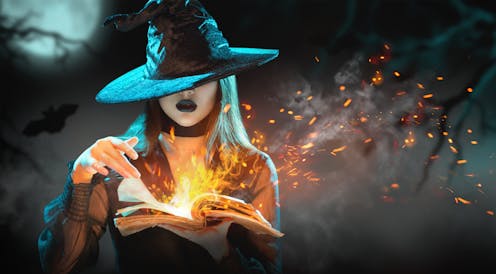
From the fairy tales read to us as children to the costumes every Halloween, the figure of the witch has been with most of us for our entire lives. Unkempt and warty, the witch of our childhood was generally a repulsive creature flying on a broomstick beside her toad or black cat.
Yet recent years have marked a reinvention of this ancient character, giving her a modern twist in a new subgenre of literature that some are calling “witch lit”.
The novels that have been categorised as belonging to this new subgenre often take inspiration from historical events such as the witch trials of the medieval and early modern periods.
A.K. Blakemore’s award-winning novel The Manningtree Witches (2021), for example, is set in the town of Manningtree in 1643 just as Matthew Hopkins begins his hunt against witches. Jenni Fagan’s short novel Hex: Darkland Tales (2022) revolves, in part, around the story of Geillis Duncan, one of the first women to be accused of witchcraft in the North Berwick witch trials.
We can see this resurgence in film and TV too. In Netflix’s Wednesday (2022), the young protagonist learns about her magical heritage through her ancestor Goody Addams, who was accused of witchcraft in the 1600s.
Popular shows like Outlander (2014), The Chilling Adventures of Sabrina (2018) and A Discovery of Witches (2018) also prominently feature historical witchcraft beliefs and practices.
The witches featured in this new media are rarely comparable to the dirty hags that appeared in older stories. The new witch is often beautiful, at once dark and gothic and ethereal and wild.
Even Disney’s sequel to Hocus Pocus (2022) features a more sympathetic version of the Sanderson sisters. Winnie Sanderson, although still a child-killing witch, now becomes a woman who values her coven of sisters above all else.
In all of this, one thing is clear: the story of the witch is being rewritten and a new type of tale is taking its place.
Kirsty Logan’s Now She is Witch
An important addition to the witch lit sub-genre is Kirsty Logan’s Now She is Witch (2023). It perfectly captures the magic of this kind of story. The novel follows Lux, a girl who sells poisons and poppets, and the mysterious Else who is seeking revenge against a lord who kills women for witchcraft.
Many of the elements we have come to expect from witchcraft literature are evident in this tale. Through her protagonist, Logan picks at the hypocrisy of the rhetoric used to condemn witches. As Else puts it: “Men desire women but it is not their fault, it’s because women are wicked”.
Lux is also on a journey of self-discovery. She is trying to understand the place that she occupies in the world and the names that have been given to her, be it maiden, mother, crone or witch. Where this novel really finds its brilliance, is in the moments that it strays from the path that has been set out for it in this genre.
The medieval setting of Logan’s story feels real and textured but there is also an otherworldly, almost carnivalesque feeling to the novel. The journey that Lux takes through woods populated by a colourful cast of characters, is almost reminiscent of the voyage Little Red Riding Hood takes to her grandmother’s house. Though Lux is as much a wolf as she is a lost little girl.
In her novel, Logan is making use of not only historical beliefs around witchcraft but also folklore and fairy tales. Her witch is complicated: powerful and somehow also powerless, woman and sometimes man and sometimes neither and sometimes both, real and made up, dangerous and innocent, girl and wolf.
Read more: WitchTok: the rise of the occult on social media has eerie parallels with the 16th century
At the centre of the story is a hunger from both Lux and Else to be allowed to be more than just one thing, to simply exist without worrying about what word or role will be used to define them.
Understanding the witch craze
It is not only in television and literature that the witch has gained popularity in recent years. Feminist activists and writers such as Silvia Federici and Mona Chollet are turning to the witch as a figure of injustice, power or rebellion.
One glance through the section of TikTok that has been affectionately named WitchTok reveals a number of people identifying as witches and calling out for power through the use of healing crystals or tarot cards.
At a time when female bodies are still policed in many parts of the world, the witch retains the power to speak through history and across generations. Perhaps this process of rewriting the witch is actually giving writers a new way to tell the stories of women.
Lucy Atkinson does not work for, consult, own shares in or receive funding from any company or organization that would benefit from this article, and has disclosed no relevant affiliations beyond their academic appointment.
This article was originally published on The Conversation. Read the original article.







